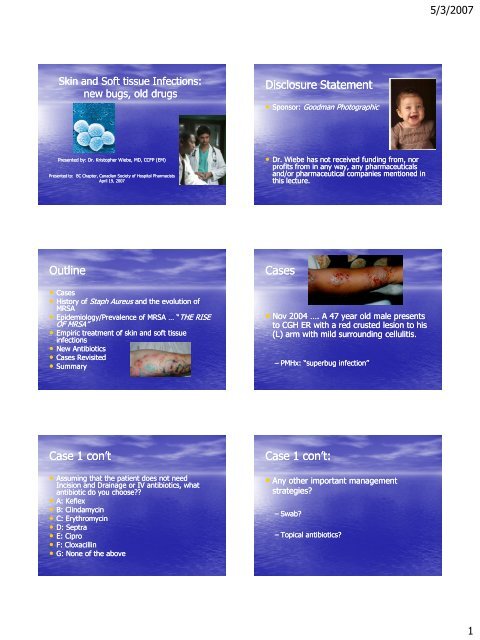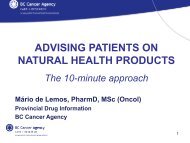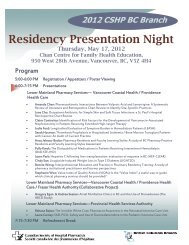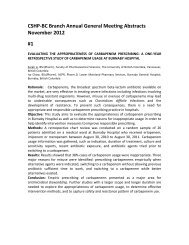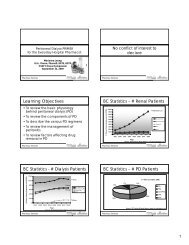MRSA (methicillin resistant staph areus) - CSHP-BC Branch
MRSA (methicillin resistant staph areus) - CSHP-BC Branch
MRSA (methicillin resistant staph areus) - CSHP-BC Branch
Create successful ePaper yourself
Turn your PDF publications into a flip-book with our unique Google optimized e-Paper software.
5/3/2007Skin and Soft tissue Infections:new bugs, old drugsDisclosure Statement• Sponsor: Goodman PhotographicPresented by: Dr. Kristopher Wiebe, MD, CCFP (EM)Presented to: <strong>BC</strong> Chapter, Canadian Society of Hospital PharmacistsApril 19, 2007• Dr. Wiebe has not received funding from, norprofits from in any way, any pharmaceuticalsand/or pharmaceutical companies mentioned inthis lecture.Outline• Cases• History of Staph Aureus and the evolution of<strong>MRSA</strong>• Epidemiology/Prevalence of <strong>MRSA</strong> … “THE RISEOF <strong>MRSA</strong>”• Empiric treatment of skin and soft tissueinfections• New Antibiotics• Cases Revisited• SummaryCases• Nov 2004 …. A 47 year old male presentsto CGH ER with a red crusted lesion to his(L) arm with mild surrounding cellulitis.– PMHx: “superbug infection”Case 1 con’t• Assuming that the patient does not needIncision and Drainage or IV antibiotics, whatantibiotic do you choose??• A: Keflex• B: Clindamycin• C: Erythromycin• D: Septra• E: Cipro• F: Cloxacillin• G: None of the aboveCase 1 con’t:• Any other important managementstrategies?– Swab?– Topical antibiotics?1
5/3/2007Case 2• A 24 year old female IV drug userpresents with an abscess to her (R)antecubital fossa:– What is the most likely inciting organism:• A: <strong>MRSA</strong>• B: Group A Strep• C: Other Strep• D: Staph aureus (MSSA)• E: ColiformsCase 2 (con’t)• Which is the most appropriate initialmanagement strategy?– A: IV antibiotics alone– B: Oral antibiotics alone– C: I and D alone– D: I and D plus antibiotics– E: It dependsCase 3• A 48 year old lawyer and his wife presentto the ER each with multiple smallabscesses• The lawyer says this is the 3 rd time thishas happened in the last year• The pair are otherwise healthy and haveno history of hospitalization, hospitalvisits, incarceration or IV drug useCase 3 (con’t)• Are there any historical factors in this case that make<strong>MRSA</strong> more or less likely as the causative pathogen?• Is there any further information necessary?• What is the most appropriate empiric treatment??– A: I and D of all lesions but no antibiotics– B: IV Vancomycin– C: IV Ancef– D: Oral Keflex– E: None of the aboveCase 4Background: Staph Aureus• 38 year old female with (R) leg abscess andsepsis. Most appropriate treatment?– A: IV ANCEF– B: IV VANCOMYCIN– D: IV CLINDAMYCIN– E: I and D plus iv Ancef– F: I and D plus iv Clinda– G: I and D plus iv Vanco– E: None of the above• Gram (+) cocci in clusters• Frequent skin commensal organism (50%)• Frequent cause of skin and soft tissue infections• Initially sensitive to Penicillin but soon became<strong>resistant</strong> (B-lactamase)• By the 1970’s Staph Aureus uniformly <strong>resistant</strong>to Penicillin– Antimicrobial selection caused gradual replacement ofPenicillin sensitive to Penicillin <strong>resistant</strong> strains.2
5/3/2007Cloxacillin, Cephalosporins andClavulinic Acid• Inherently <strong>resistant</strong> to B-lactamase• Therefore have been the drugs of choicefor treating Staph Aureus for decades.They also cover Group A Strep; ; thereforeare ideal drugs for skin and soft tissueinfections!• But wait ……. !!!!<strong>MRSA</strong>: Methicillin Resistant StaphAureus• <strong>MRSA</strong> 1 st identified in late 60’s• By mid-80’s became a commonnosocomial infection/colonizer• Resistant to all B-lactams by virtue ofalterations in transpeptidase (Penicillinbinding protein).• Rare in the non-hospitalized patients….but wait ….!!!!!CA_<strong>MRSA</strong>: Community Acquired<strong>MRSA</strong>• Late 90’s – early 2000’s: sporadicoutbreaks of <strong>MRSA</strong> in non-hospitalizedpatients identifiedCA-<strong>MRSA</strong>: case definition• <strong>MRSA</strong> isolated from an individual who hasnot recently been in contact with a healthfacility.• These outbreaks were labelled CommunityAcquired <strong>MRSA</strong> based on the lack contactwith health care facilities.CA-<strong>MRSA</strong>: cytogenetic definition• CA-<strong>MRSA</strong> is a genetically distinct organism fromHA-<strong>MRSA</strong>.• 99% of CA-<strong>MRSA</strong> comes from a single clone(USA 300 Clone)• CA-<strong>MRSA</strong> possesses virulence factors notpossessed by HA-<strong>MRSA</strong>, making it a particularlyaggressive organism– Panton-Valentine Leukocydin factor (PVL gene)– Damages the cell membranes of Neutrophils,Macrophages and Monocytes, ultimately lysing themSpider Bites and <strong>MRSA</strong>• A 47 year old Male presents with a spiderbite.– What kind of a spider produces thischaracteristic bite?• Brown Recluse• Black widow• Violin Back• <strong>MRSA</strong> spider3
5/3/2007Risk Factors for CA-<strong>MRSA</strong>(traditional/sporadic outbreak)• SPIDER BITE (pt identified)• IV Drug Use• Homeless / indigent• Incarceration• Sports teams• Poverty• Multiple Abscesses• Known Contact with <strong>MRSA</strong>• Recent Antibiotic Use and / or failure– (ie Keflex failure = <strong>MRSA</strong> until proven otherwise!!)<strong>MRSA</strong>: new risk factor• The single biggest predictor of <strong>MRSA</strong> infection?• Abscess (likelihood ratio 20-30)Aug 17, 2006• All traditional risk factors of secondaryimportanceCA-<strong>MRSA</strong> : who cares?!?• You should!• WHY?CA-<strong>MRSA</strong>: prevalence• Texas:– 1990: 2.3%– 2001: 40.3%– 2005: 78%• California:– 51% of all skin and soft tissue infectionswere <strong>MRSA</strong> at the infection site!– Annals of Emergency Medicine, 2005CA-<strong>MRSA</strong>: PrevalenceCA-<strong>MRSA</strong>: prevalence• New England Journal of Medicine• Talon Et Al 2006– Multi-Center Trial (11 centres acrosscontinental US) 2004• 59% of all infection site isolates were<strong>MRSA</strong>• Conclusions: “<strong>MRSA</strong> is the most commonidentifiable cause of skin and soft-tissue tissueinfections among patients presenting toemergency departments in 11 U.S. cities.When antimicrobial therapy is indicatedfor the treatment of skin and soft-tissue tissueinfections, clinicians should considerobtaining cultures and modifying empiricaltherapy to provide <strong>MRSA</strong> coverage”.4
5/3/2007Implications:• Clinicians should consider modifying theirpractice to empirically cover <strong>MRSA</strong> andobtain wound cultures in ALL skin andsoft tissue infectionsCA-<strong>MRSA</strong>: implications for FraserHealth• So does this all apply to us???• YES!!!CA-<strong>MRSA</strong>: Local Prevalence<strong>MRSA</strong> local prevalence• Guesses??• K. Wiebe Case Series (Aug 27 2006 - Dec 112006) CGH ER / Walk In Clinic• 13/18 skin infections <strong>MRSA</strong> = 72 %• 4/18 MSSA = 28%• 4/18 MIXED (<strong>MRSA</strong>/MSSA + STREP)= 28%• 72% of ALL skin infections• 100% of abscesses• 100%5
5/3/2007Chilliwack ER data (2006):Bottom Line:• 153 Staph. Aureus isolates• 88 <strong>MRSA</strong>• = 57.5 %(courtesy Dr. B Mack)• <strong>MRSA</strong> is the most common isolate from skin andsoft tissue infections in the US.• <strong>MRSA</strong> is probably the most common isolate fromskin and soft tissue infections in Chilliwack, andthis likely extrapolates to all of Fraser Health.• <strong>MRSA</strong> will replace MSSA over the next 10-20years just as Pen <strong>resistant</strong> SA replaced PenSensitive SA 30 years ago.Bottom Line:• Clinicians should empirically cover <strong>MRSA</strong> inall complicated and/or severe skin andsoft-tissue tissue infections.• Clinicians should empirically cover <strong>MRSA</strong> inany infection likely to be caused by <strong>staph</strong>aureus(eg/osteomyelitis/endocarditis/necrotizingpneumonia)Bottom Line:• Hospital Pharmacists should recommendantimicrobial coverage with activityagainst <strong>MRSA</strong> for seriously ill patients withskin and soft tissue infections.So do I need to throw out theAncef/Keflex???• Not Yet, Orthopedic surgeons!• Ancef is probably still useful in PUREcellulitis. … Why?Cellulitis vs Abscess• Limitation of aforementioned data is abilityto culture the wound.• Abscesses = easy, cellulitis = hard• Therefore, the above data applies towounds with purulent exudate• Pure cellulitis is more likely to be Group AStrep (Abrahamian, 2006)6
5/3/2007What if it looks like this?– So: if it looks like this you can still use Ancef,– Provided it is not a life-threatening infectionIs it likely to be <strong>MRSA</strong>?Yes: the presence of pus indicates @ leasta 50% likelihood of <strong>MRSA</strong> based on allavailable data.So how do you treat suspected <strong>MRSA</strong>??<strong>MRSA</strong> susceptibilities• CA-<strong>MRSA</strong> is predictably susceptible toseveral common antibiotics:• Septra (100%)• Rifampin (100%)• Doxycycline (86-92%)• Clindamycin (94-95%) 95%)• Universally <strong>resistant</strong> tocephalosporins/penicillins/macrolides/quinolonesLocal SusceptibilitiesCaveats• Rapid resistance to Rifampin– Therefore not used as monotherapy• Inducible Clindamycin resistance– Estimated @ 2-10% in US trials– Possibly up to 47% in Fraser East– Clinical significance uncertain: treatment failuresreported• Probably excludes Clindamycin monotherapy7
5/3/2007What About Septra??• Probably not a good empiric monotherpayagent: why?• No Group A Streptococcal coverage• Doxycycline, likewise, has imperfect strepcoverage.Recommendations: minorinfections, possible CA-<strong>MRSA</strong>requiring antibiotics• Empiric therapy = combination therapy• Septra + Clinda or Rifampin or Keflex• Clinda + Septra or Doxy or Rifampin• Combination therapy ensures coverage of bothstrep and <strong>staph</strong>, and limits emergence ofresistance.Serious/Life threatening Infectionspotentially due to <strong>MRSA</strong>• Vancomycin + Ancef/Clinda/Clox• Addition of 2 nd agent needed as someevidence to suggest Vanco not as good forMSSA.• Other options = IV Septra / IV LinezolidMinor Abscess: no surroundingcellulitis, no systemic features• Incision and Drainage only• Does not apply to multiple abscesses8
5/3/2007New AntibioticsCases revisted• DAPTOMYCIN (CUBICIN)• Acitve against <strong>MRSA</strong> MSSA STREP• Cyclic lipopeptide• Tigecyclin (Tigacyl)– 1 st glycylcycline– Active against mrsa mssa strep and gram negs• Both FDA approved: Health Canada pending• 1.) 48 year old Male, history of “superbug”:treatment?• Swab plus 2 of: Clinda/Septra/Doxy/Rifampin• 2.) 26 year old Female, IV drug user, antecubitalabscess: Organism? Treatment?• Organism = <strong>MRSA</strong>!• Treatment = I and D +/- combo therapyCases revisited• Husband and Wife, abscesses• More info?• Treated with keflex 3 times for previousepisodes• Almost certainly <strong>MRSA</strong> based on multipleabscesses and multiple courses of Keflex eventhough no other identifiable risk factors• Treatment?• I and D, Swab, Combination therapySummary• CA-<strong>MRSA</strong> is highly prevalent as a cause of skinand soft tissue infections• CA-<strong>MRSA</strong> = virulent/aggressive• CA-<strong>MRSA</strong> will replace MSSA in a matter of years• Abscess/purulent skin infection = <strong>MRSA</strong> untilproven otherwise• Serious/life threatening skin and soft tissueinfections must be treated with antibiotics activeagainst both <strong>MRSA</strong>/MSSA and strepSummaryQUESTIONS ?!?!• Septra, Doxy, Rifampin and Clinda can beused in combination when oral therapy isindicated.• Vancomycin remains the agent of choicewhen iv therapy is indicated• New antimicrobials may soon be available• Small uncomplicated abscesses can still betreated with primary I and D alone.9
5/3/2007Thank You10


